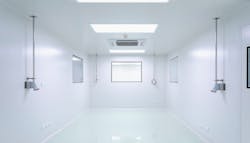The United States leads in pharma and biopharma manufacturing, with biologics, gene therapies, and vaccines driving the demand for cleanroom construction. A November 2024 Global Market Insights report states U.S. cleanroom construction exceeded $1.2 billion in 2023 and is expected to grow at over 7.1% CAGR from 2024 to 2032, with pharma holding a significant market share.
But finding suitable real estate for a cleanroom installation can be challenging. Besides managing the significant expenses, companies must assess whether the building fulfills the necessary location, structural, and utility requirements to accommodate their operational demands and comply with regulatory standards.
Location, location, location
Though part of a larger facility, nearby activities can impact cleanroom conditions. An ideal site should minimize exposure to particle contamination risks, like high exhaust levels or heavy industry.
Cleanrooms should be placed away from heavy truck traffic, loading docks, and industrial sites to prevent air pollution, vibration, and noise that may release particles. Natural hazards like floods, earthquakes, and wildfires must also be assessed for operational risks. Reliable access to electricity, water, suppliers, and staff is crucial for efficient pharma manufacturing. Lastly, the building in question should comply with local zoning laws and scientific and industrial use regulations. Any regulations relating to waste disposal, emissions, or water use that may impact operations should be identified before committing to a particular site.
Structural suitability
Cleanrooms need 16 to 20 feet of clear space for HVAC systems, including plenums, HEPA filtration, humidifiers, dehumidifiers, and air-handling equipment. Lower floor-to-floor heights can compromise efficiency and function. The structure must also support the cleanroom’s weight, including filtration systems, airflow controls, and heavy vibration-sensitive equipment.
Further, the building must be able to accommodate future growth, cleanroom expansions, or scaling up operations. Ideally, such a space should have easily adaptable attributes that can be reconfigured as technology evolves, upgrades occur, and regulatory requirements change.
HVAC and piping
Cleanrooms are mechanically intense, requiring more HVAC, chilled water, steam, and heating hot water than most facilities. Understanding how workloads fit within the building’s infrastructure is crucial. Low floor heights or lightweight steel may require extra substructures to support HVAC and process piping. The building must have proper outdoor air intake locations, away from facility exhausts and areas with vehicle traffic or idling.
Electrical infrastructure
Cleanrooms consume substantially more energy than non-classified rooms, requiring electrical power to accommodate HVAC process equipment and support process systems. HVAC systems use 50% to 75% of a cleanroom’s electricity due to high airflow. Process applications also require varied voltages (120, 230, 277, 480), so existing power infrastructure must be evaluated.
Many pharma companies adopt green standards like LEED. Facility selection should consider energy-efficient design and renewable energy options.
- Obtaining assistance for site evaluations
- Consulting an architect and engineer is essential to confirm a property’s suitability for a cleanroom project, including attributes such as:
- Adequate space and infrastructure to support cleanroom construction
- Absence of environmental hazards and contamination risks
- Sufficient power supply of the appropriate type
- Compliance with local zoning and regulatory requirements
- Flexibility to accommodate future expansion and technology upgrades
Taking the time to assess these factors will ultimately lead to an optimal cleanroom environment that meets current needs and future growth potential.






